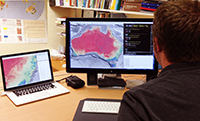News
New data builds understanding of Australia's precious soil resources
Published:27 November 2014
Researchers from across Australia have joined together to develop a comprehensive set of digital maps of the country's soil and landscape attributes.
The information will support a spectrum of natural science research, agricultural production, environmental management and infrastructure development applications, from continental scale down to regional and farm scales.
The Soil and Landscape Grid of Australia consists of a suite of soil and landscape attributes such as soil water, nutrients and clay, which affect the sustainability of Australia's natural resources and the profitability of sectors such as agriculture, mining and infrastructure. The maps have been generated using innovative spatial modelling and digital soil mapping techniques to produce a fine resolution 3 arc-second grid of soil attribute values across Australia.The entire continent is now represented as a digital grid with two billion 'pixel' that are about 90 by 90 metres, down to a depth of two metres below the surface. The dataset provides a significant improvement over existing national soil information in Australia.
The mapping approach combines historical data collected over many decades with new airborne and satellite data, quantitative sample analysis and new modelling techniques. Key soil attributes, including bulk density and pH, have been modelled and estimated at six defined depth intervals, ranging from 0-5 centimetres down to a total depth of two metres. Landscape attributes that have been incorporated include solar radiation, index, slope, relief, curvature, topographic position, wetness and aspect.
Geoscience Australia provided a range of supporting geoscientific datasets, including Landsat imagery, airborne geophysics and soil samples as part of a national geochemical survey, and surface geology datasets integral to the modelled outputs.
The development of the Soil and Landscape Grid was a collaborative effort by researchers from a range of Australian Government and State/Territory partner agencies and the University of Sydney. The work was supported through the Terrestrial Ecosystem Research Network (TERN), part of the Australian Government's National Collaborative Research Infrastructure Strategy.
The maps are provided for free. Users can view the maps in different ways via the website and can also download partial or full datasets through CSIRO's online Data Access Portal.
Email:





